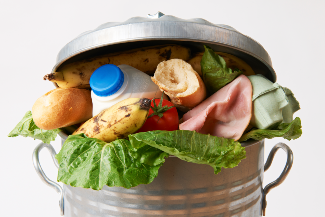Member State Page : Sweden
Last updated on the 29/09/2023

Per capita: 90 kg in 2020
In total: 905 000 tonnes in 2020
In total: 900 000 tonnes in 2021

Retail and other distribution of food: 97 000 tonnes in 2020
Restaurants and food services: 98 000 tonnes in 2020
Households: 635 000 tonnes in 2020

National targets:
1) from 2020 to 2025, the total amount of food waste should be reduced by at least 20% by weight per capita
2) by 2025, an increased share of the food production should reach retailers and consumers
Contact point
- Swedish Food Agency: consumers | businesses, catering (private and public)
- Swedish Board of Agriculture (primary production, industry - food losses)
Target
The Swedish Government has adopted two milestone targets within Sweden's environmental objectives that aim to reduce the total food loss and waste generated along the entire food supply chain, in accordance with the Sustainable Development Goal Target 12.3 (SDG 12.3). The two milestone targets are:
- From 2020 to 2025, the total amount of food waste should be reduced by at least 20% by weight per capita.
- By 2025, an increased share of the food production should reach retailers and consumers.
All milestone targets are followed up on a regular basis, with annual reports for the government and an in-depth evaluation once every parliamentary term. The two milestone targets are also part of the revised Swedish waste management plan and waste prevention program 2018-2023.
Measure
The Royal Swedish Academy of Sciences carried out a project to establish definitions and methods to measure food loss and waste at company level. Its results are being tested in the Swedish voluntary agreement for reducing food waste in the food supply chain.
Sweden has been measuring national food waste levels since 2012, regularly developing and evaluating measurement methods for the different stages of the supply chain. The Swedish waste legislation includes the definition of food waste and the general reporting requirements laid down in related EU legislation. The baseline years are 2020 for reporting food waste levels along the supply chain from primary production to consumers and 2021 for reporting on food losses up to retail.
The Swedish Environmental Protection Agency publishes national information on the amount of food waste and the waste treatment of food biannually and additional information on food loss and waste within the yearly communication and evaluation of the environmental objectives system and targets.
The Swedish Board of Agriculture has established a methodology for measuring food losses and waste at national level in the food production chain starting with primary production, up to retail and consumer stages of the supply chain. The project [report summary in EN], carried out in collaboration with farmers and industry organisations, university and research institutes, focuses on measurement methods for eight commodities (beef, pork, milk, fish, potatoes, carrots, strawberries and wheat), selected due to their high production value, environmental impacts etc. The methods are based on processing already existing data, but also include other monitoring methods such as investigations, surveys and interviews.
Other on-going projects in the primary production sector cover resource efficiency at pork and beef farms, including advisory tools, and valorisation opportunities for broccoli plants. Data indicate that 295 000 tonnes of side flows or 98 000 tonnes of food are wasted at primary production level after harvest/slaughter/catch (Nordic studies 2010-2013); 9 % of the beef production relative to slaughtered weight does not reach the food chain (2012); losses in iceberg lettuce account for 65 % of the total production (2014); 33 % of egg laying hens do not become food and 5,6 million rooster chickens are lost in egg production (2015).
In 2018, five grocery store chains, covering around 80% of the market, voluntarily reported on their food waste data to the Swedish EPA, offering an estimate of the levels of food waste in the sector.
The Swedish Food Agency has developed in 2018 a national measurement method for food waste in public meal restaurants, with a first national mapping of edible food waste from lunches in municipal pre-schools, schools and elderly homes carried out in 2019. Meal managers in Sweden’s municipalities were invited to respond to a voluntary survey on edible food waste. A measurement log in Excel was also developed and can be used freely by both public and private food businesses in the food services sector. A handbook to reduce food waste in the public meal sector was also published in March 2020.
Act
The national food strategy for Sweden and its related action plan for food loss and waste reduction put forward several measures towards reaching the SDG Target 12.3. The Swedish National Food Agency together with the Swedish Board of Agriculture and the Swedish Environmental Protection Agency (EPA) have been tasked with implementing the food loss and waste prevention measures foreseen in the action plan. The action plan ‘More to do more’ identifies four focus areas: national goals and development of monitoring methods; active collaboration between industry players of the food supply chain; investigation, research and innovation; changes in consumer behaviour.
Food is one of the priority areas in the Swedish circular economy strategy, which includes measures to decrease food losses and food waste. Prevention of food waste is also included in the national waste management plan and the waste prevention programme. The Swedish waste legislation includes a food use hierarchy that specifies the most favourable options for handling surplus food.
A national voluntary agreement was established in Sweden in March 2020, based on the blueprint for such initiatives developed by the EU-funded REFRESH project. In the national voluntary agreement - Swedish Collaboration for the Reduction of Food Waste (SAMS), actors in the food value chain collaborate to identify the hotspots and causes for food loss and waste. The agreement is built on three components: the goals to reduce food loss and waste, data collection for monitoring the goals of the agreement and for identifying hotspots across the value chain, as well as a forum for exchange gathering stakeholders along the food value chain. The Swedish EPA, the Swedish National Food Agency and the Swedish Board of Agriculture are also collaborating to reduce food waste with a large number of actors through The Food Waste Network, a network that gathers public authorities, researchers, interest groups and the food industry.
Sweden carried out research to investigate ways to increase the use of surplus food and production residues as feed. The project report [SV, summary in EN] looks into related legislation and discusses barriers and opportunities.
The Swedish Board of Agriculture has been involved in the work implementing the legislation regulating UTP (Unfair trading practices), discussing with primary producers and food industry about how UTP affects their businesses as well as leads to food loss and waste in order to take their perspective into account. A pre-study on trading fruit and vegetables in Sweden published 2018 investigated whether unfair trading practices lead to increased food waste in the country.
Financed by Sweden's innovation agency Vinnova, Resvinn is a large project launched in 2020, aiming to reduce food waste by developing efficient redistribution systems of surplus food, from stores and wholesalers to restaurants and schools. The focus is to develop solutions related to logistics, business models, IT systems, communication and behavioural changes.
The Swedish Food Agency organised a public awareness campaign for social media, popularising the new term svinniska as a way to describe consumer actions to reduce food waste (e.g. meal planning, storing food, using leftovers etc.). The campaign aims to increase consumers’ knowledge about the environmental impacts of food waste, to promote ways to reduce food waste at home and to motivate consumers to take such action. Guidance on how to use this concept in communications has been made available for free use by all interested stakeholders. During Christmas 2020, the Swedish Food Agency also launched an awareness campaign to disseminate tips related to date marking.
A consumer survey about food waste in households was published in March 2021.
As part of the action plan for food loss and waste reduction, the Swedish Food Agency is also carrying out research on consumer behaviour to reduce food waste. A behavioral project was launched in 2020, aiming to investigate how consumer interventions using the nudge technique can have an impact on reducing consumer food waste. Pilots of such interventions took place throughout 2021 in grocery stores and a report will be published late 2021.
Relevant resources
Links
